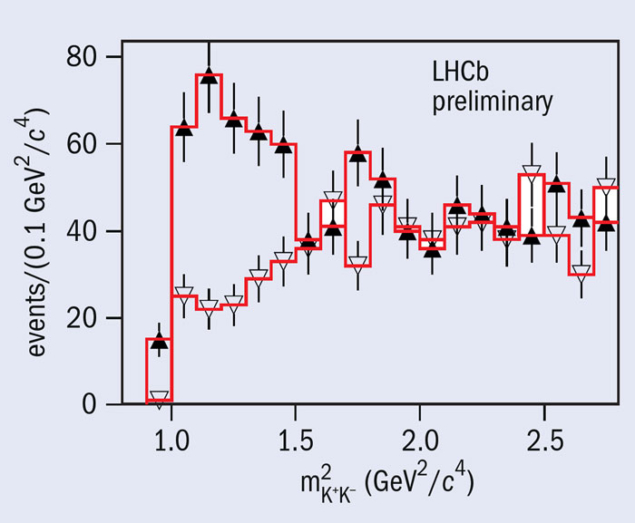One of the interesting ways to search for CP violation in B-meson decays is by using three-body decays of charged B mesons, i.e. B+ →K+K–K+, K+π–π+, K+K–π+ and π+π–π+ (and the charge-conjugated modes). In the 1.0 fb–1 of data accumulated in 2011, LHCb already recorded samples of these decays that are an order of magnitude larger than those available to previous experiments. The first studies of the K+K–K+ and K+π–π+ decays were presented by the collaboration at the 2012 International Conference on High-Energy Physics in July, revealing evidence of large CP-violation effects (LHCb 2012a). Now, at the 7th International Workshop on the CKM Unitarity Triangle, held at the end of September, LHCb has complemented these with results from the rarer decays to K+K–π+ and π+π–π+, finding evidence of even larger CP violation (LHCb 2012b).

While the inclusive CP asymmetries (which are integrated over the entire phase space, or the Dalitz plots, of the three-body decays) show evidence of CP violation, more pronounced effects are visible when looking at the variation of the effect in different regions. The LHCb analyses have used model-independent approaches – based on binning the Dalitz plot – to explore the local asymmetries.
A remarkable feature of the new results is that the CP-violation effects appear to arise in regions of the Dalitz plots that are not dominated by contributions from narrow resonances. For example, previously the BaBar collaboration observed a broad feature at low values of the K+K– invariant mass in B±→K+K–π± decays (Aubert et al. 2007); in the LHCb data, this appears to be present only in B+ decays, as the figure shows, indicating direct CP violation in these decays. This points to some interesting hadronic dynamics that must generate the strong (CP conserving) phase difference that is necessary for direct CP violation to emerge.
To understand these effects further, the LHCb collaboration is now starting detailed studies of these channels and will also exploit the larger data sample that will be available after the 2012 running. The results from these analyses will also establish whether the observed CP violation is consistent with the expectations of the Standard Model or whether it has a more exotic origin.
Further reading
B Aubert et al. BaBar collaboration 2007 Phys. Rev. Lett. 99 221801.
LHCb 2012a LHCb-CONF-2012–018.
LHCb 2012b LHCb-CONF-2012–028.








